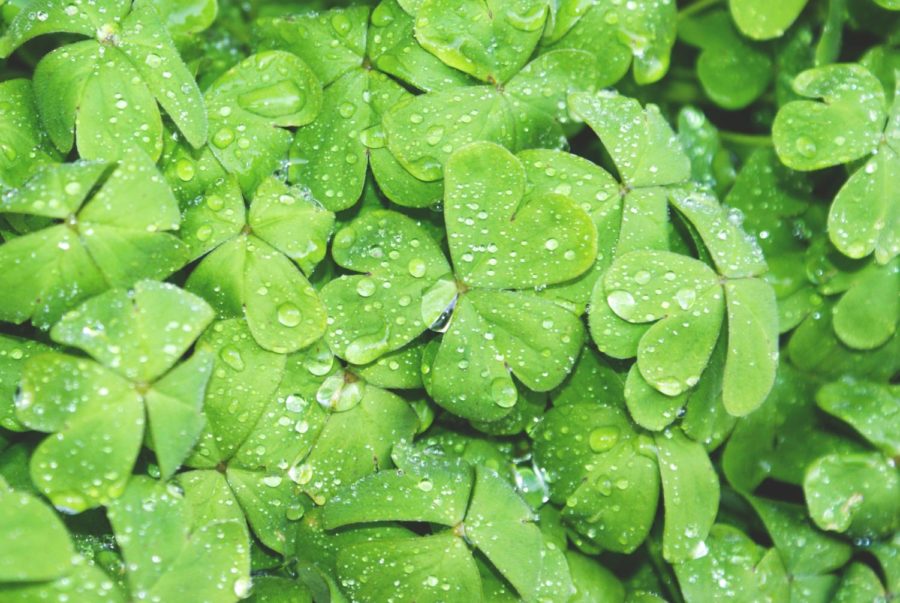The History of St. Patrick’s Day
A cluster of clovers to commemorate St. Patrick’s Day.
Dia dhuit! (Irish for hello)
Since the 17th century, St. Patrick’s Day has been celebrated around the world in light of Irish culture. Falling on the death anniversary of the National Apostle of Ireland, Saint Patrick, the holiday is filled with shades of green and an abundance of food to honor his death. This particular holiday has been looked forward to by many, including AAHS students.
Freshman Zoe Kirchgessner says, “I like the shamrock symbol and how people wear green. I also like joking around with those who don’t wear green because of the ‘pinching’ that goes on.”
As a matter of fact, pinching has been in vogue on St. Patrick’s Day for years. The story behind pinching according to Elite Daily, is that those who wear green are invisible to Leprechauns (mischievous Irish folklore fairies), and those who don’t are pinched by the notorious creatures. Since the color green uplifts the Irish culture, people who wear the color participate in pinching the unfortunate people who don’t, to encourage them to celebrate the culture the following year. Wear your green or suffer the consequences!
Contrary to popular belief, St. Patrick’s Day is originally a religious holiday observed by branches of Christianity. Saint Patrick is at the center of the day’s attention. There are several different legends claiming to be the reason that he’s the figure that he is, but the most popular one states that he explained the Holy Trinity. Saint Patrick was (and still is) an important Irish individual known for his capture when he was 16 years old and other struggles. He’s also known for being a great religious figure serving as a bishop, cleric, and missionary. To commemorate St. Patrick’s Day, the people that religiously recognize the holiday go to church in the morning and “live it up” later on in the evenings.
Although the holiday is Irish, the United States was the first to hold a parade in its honor. New York held the first parade in 1762, while Ireland didn’t hold their first parade until later on in 1903. Despite this fact, Ireland extensively celebrates the holiday today. With their wide selection of beverages and abundance of treats and favors, Ireland is the place to be for St. Patrick’s Day.
Today, St. Patrick’s Day is a popular holiday celebrated all around the world to uplift Irish heritage and culture. People usually dress in their best green attire with accessories that glorify the Irish culture, such as themed stickers and temporary tattoos. Those interested also indulge in popular Irish foods, such as potatoes and cabbage, and attend activities. Alcohol is also a huge part of the holiday, and according to TIME, $4.6 billion dollars are spent on the beverage worldwide, the most popular being Guinness, which is an Irish brewed drink. As a result, the holiday is a boomer for several businesses.
Identical to all holidays, St. Patrick’s Day has its fun facts as well. To begin with, Mental Floss says that Saint Patrick actually associated himself with the color blue rather than green. It wasn’t until later in the 18th century during an independence movement that the color green became the core of the holiday. Also, several people commonly find themselves asking what the importance of the shamrock with the holiday is. Apparently, Saint Patrick used the three-leaved plant to explain the Holy Trinity!
To summarize, St. Patrick’s Day is a holiday of celebration towards the Irish lifestyle. This event allows opportunities for all ages, making it more enjoyable. Don’t forget to engage in the holiday! May the luck O’ the Irish be with you!
History.com Staff. “History of St. Patrick’s Day.” History.com, A&E Television Networks, 2009, http://www.history.com/topics/st-patricks-day/history-of-st-patricks-day.
wikiHow. “How to Celebrate St. Patrick’s Day.” WikiHow, WikiHow, 6 Feb. 2018, http://www.wikihow.com/Celebrate-St.-Patrick%27s-Day.
“15 Things You Might Not Know About St. Patricks Day.” Mental Floss, 15 Mar. 2014, http://mentalfloss.com/article/55599/15-delightful-facts-about-saint-patricks-day.

Hello there! My name is Leilani and I'm a Copy Editor for the Jetsream, and a senior at AAHS. I'm currently part of the Orchestra playing violin, and the...








